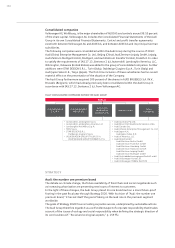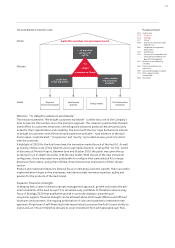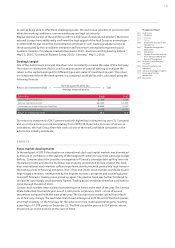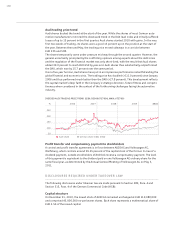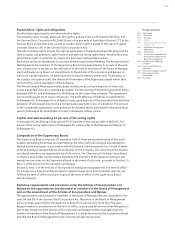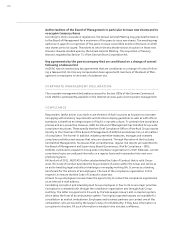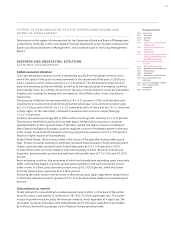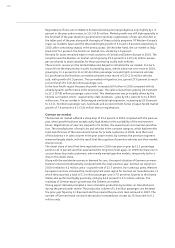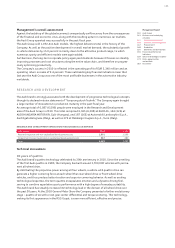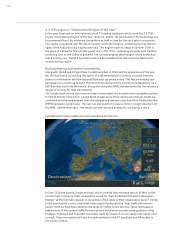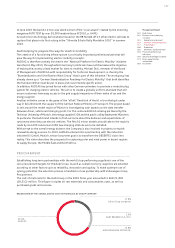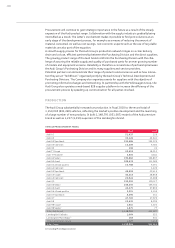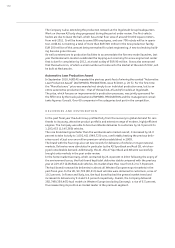Audi 2010 Annual Report Download - page 143
Download and view the complete annual report
Please find page 143 of the 2010 Audi annual report below. You can navigate through the pages in the report by either clicking on the pages listed below, or by using the keyword search tool below to find specific information within the annual report.
141
Management Report
132 Audi Group
132 Structure
134 Strategy
137 Shares
138 Disclosures required under
takeover law
140 Corporate management
declaration
140 Compliance
141 System of remuneration for
the Supervisory Board and
Board of Management
141 Business and underlying
situation
141 Economic environment
143 Research and development
147 Procurement
148 Production
150 Deliveries and distribution
156 Financial performance
indicators
159 Social and ecological aspects
173 Risks, opportunities
and outlook
183 Disclaimer
SYSTEM OF REMUNERATION FOR THE SUPERVISORY BOARD AND
BOARD OF MANAGEMENT
Information on the system of remuneration for the Supervisory Board and Board of Management
is provided in the Notes to the Consolidated Financial Statements under “Details relating to the
Supervisory Board and Board of Management” and constitutes part of the Group Management
Report.
BUSINESS AND UNDERLYING SITUATION
ECONOMIC ENVIRONMENT
Global economic situation
2010 saw the global economy recover unexpectedly quickly from the global economic crisis,
even if the speed of the upturn slowed somewhat in the second half of the year. In 2010 as a
whole, global economic output grew by 4.1 (– 1.9) percent. This development owed much to
expansive monetary policies worldwide, as well as to the rapid progress of emerging countries,
most notably China. By contrast, the economic recovery in many industrial countries was weaker.
Despite price increases for energy and raw materials, the inflation rate in most countries re-
mained low.
The economy in Western Europe expanded by 1.8 (– 4.1) percent in 2010, with the debt crisis
clouding the economic environment throughout the whole year. Gross domestic product grew
by 1.5 (– 4.9) percent in the UK, by 1.5 (– 2.5) percent as well in France and by 1.0 (– 5.1) percent
in Italy. Spain, on the other hand, remained in recession with economic output falling by
– 0.2 (– 3.7) percent.
Germany recovered surprisingly fast in 2010, with economic growth reaching 3.6 (– 4.7) percent.
The economy benefited in particular from high export demand and a recovery in consumer
spending thanks to the improved state of the labor market and higher consumer confidence.
Most Central and Eastern European countries regained a course of moderate growth in the year
under review. In particular the Russian economy enjoyed clear expansion of 4.0 (– 7.9) percent
thanks to higher exports of raw materials.
In the United States, the economy cooled in the course of the year after having made a good
start. Private consumer spending in particular remained muted because of high unemployment.
Overall, gross domestic product in the United States grew by 2.9 (– 2.6) percent in 2010.
In Latin America the economic situation improved markedly in 2010. Above all in Brazil and
Argentina, gross domestic product bounced back with growth rates of 7.5 (– 0.6) and 8.3 (0.9)
percent.
Asia’s emerging countries, the economies of which had already been expanding again since early
2009, achieved the highest economic growth rates anywhere in the world during the period
under review. In China, gross domestic product was up 10.3 (9.2) percent, while the Indian
economy likewise grew vigorously by 8.5 (6.5) percent.
Following the sharp slump in the economy in the previous year, Japan regained an upward trend
in 2010 and achieved economic growth of 4.3 (– 6.3) percent mainly thanks to increased export
demand.
International car market
Global demand for cars exhibited a marked upward trend in 2010, on the back of the global
economic upturn, and gained 11.4 percent to 58.7 (52.7) million passenger cars. The power-
houses of growth were principally the Asian car markets, which expanded at a rapid rate. The
car market moreover improved in the United States and in the major Latin American markets.
By contrast, demand for passenger cars in Western Europe remained weak.





